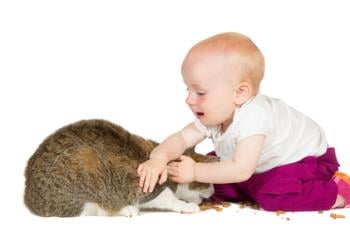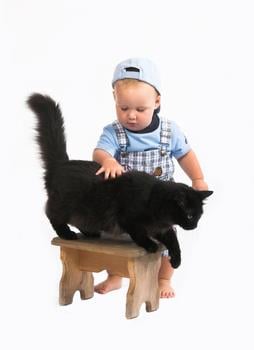
Is your cat threatened by your toddler? Many believe toddlers are vulnerable ones who must be protected from claws of aggressive house cats. However, it’s not uncommon when tables are turned, and the cat becomes in need for help.
Remember a TV film “Shrek the Halls”? When Puss in Boots arrived to Shrek’s house, he spotted three ogre kids and declared: “Okay, I will assume the position”. If you have ever been in a room with a toddler and a cat, you’ll know what it’s about.
The problem is, you can’t be harsh to any part here. Neither your cat, nor the kid. In order to make both safe and happy, you will need to work in two directions. One is changing your cat’s environment, so he feels more confident and safe, and the other is the actual training lessons with your toddler. So, let’s start with the first one…
Is there a place for your cat to hide?
The thing is, it’s really hard to work with your toddlers behavior. That is, you can work with it, we will discuss it below, but the main success will be in providing a safe environment for your cat. Is there a spot where your cat can escape the toddler?
- Get a cat tree. Actually more than one. The trick is, your cat climbs up, and the toddler stays below; thus the cat is safe. Make sure the cat tree is stable and your toddler is not able to climb it (Oh, yes, they usually can. And they usually do!). If necessary screw it to the wall and remove bottom shelve or ladder. For example, ladder at the bottom of the cat tree serves nice for architectural purposes and for human toddlers to climb; however, it is of a very little use for your cat.

Photo: © david fazey
Also, very important, you must leave your cat alone, if he jumps up on the cat tree or other provided location. It must become his private location, where he is never disturbed by you, and especially by your toddler. So, when you implement the steps described below, make sure you don’t do them if your cat jumps up and wants to be alone. His privacy is the law.
Now you can “train” your toddler to be nice to the cat
Of course, training a toddler might even be harder than training a cat, we, both parents and pet owners know this.
At the current moment, you may see like anything you teach your toddler gives no result. However, it’s not like that. Kids at toddler age are like a sponge and gathers information in amounts unimaginable by us. What they see, what they do, what they experience. The thing is, they rarely make use of this information, but it sinks in, and will be used later on.

It’s similar for kittens. Studies show, most stuff kittens learn by observing their mother. However, most of what they see is rarely repeated by themselves instantly. Not until the age of several months, when kittens are in their new homes and recall how it’s done.
And, we don’t think we’re insulting anyone, human babies are no different from kittens. What they see, what they experience, sinks in and is put in use later in their lives. So ,early experience is extremely important, even if it appear useless right now.
Do not punish your kid!
Oh, this is what we usually tell about cat training, and dog training, and is no different for human babies. It’s not only about the fact that punishment is harsh, or that physical punishment can even lead to a jail sentence in some occasions. What makes it even less appealing, it does not work. Punishment teaches nothing.
Some say it gives the result, yes, it may, but only because your kid becomes scared of you. He learns not to do unwelcome stuff just because he’s afraid of the consequences, but he will not understand why it is bad to hug his cat. He’s not planning anything evil after all. So, we’ve come to a very important conclusion.
Your toddler’s intention is not to hurt the cat!!! He just does what he thinks is right, so, it’s your turn to show him how it’s best done. So, whenever your toddler “hugs”, or grabs, or pulls your cat by the tail, interrupt this action, without anger and redirect him to the desired action (see steps below).
How to pet a cat properly?
Problem here is, many adults don’t know how to pet a cat properly, either, so we might start with a short introduction:
Cat’s love it being gentle, by slow strokes against his head an upper part of the body. Many cats also like the hind part of the body or even touching their tail, but an extremely important area to avoid is your cat’s belly.
Some cats do allow petting their belly, especially if they are used to humans doing it since their birth. However, you must be aware that naturally it’s the most vulnerable and private spot of your cat’s body, which is out of bonds for most cats.
So, basically it’s his head and back, slow strokes and rubbing with fingers. Anything else, it’s not petting and may get him either angry on in a playing mood, which both can get you scratched. Jackson Galaxy (cat behaviorist) in his show “my cat from hell” told that trying to pet and play with your cat simultaneously is like eating and brushing your teeth at the same time. So, we hope you got the point – petting is gentle. Active movements are for playing. And they do not go together.
And, again, each cat is individual. Some even do not like petting at all. The trick is, as you approach, or pet your cat, check his body language (Read here how to notice your cat expressing dislike). It tells you a lot about his mood, and if your cat “says” he does not want to be petted right now, or does not like to be petted in a specific location, you will both benefit if you leave him in peace. You can read more about why your cat may be biting you during the petting here.
How to teach your toddler to pet cat properly

So, now you have basic knowledge in how to pet your cat, you can start passing this knowledge to your toddler. No one (and hopefully you too) expects your toddler or even baby understand the concept of this skill, but it’s very important to start as early as possible, and to repeat it as often as possible.
Every day as a minimum, and definitely, every time right after your toddler becomes harsh to your cat (except times when you cat runs away and jumps up to his private locations, signaling you he wants to be left alone).
- Set your cat in a “I like to be petted now” mood. This part is important if your cats tend to scratch your toddler. Make sure your cat is relaxed, and accepts petting. You may first pet him yourself for a short time, so to “set” him for this activity. Good moments are after the meal and as your cat is napping (just make sure he’s aware of your presence). Bad times may be after playing or when your cat is stressed up. If he is, for example, right after your toddler pulled him by the tail, you first must soothe him by gently petting him yourself.
- Take you toddler in your arms, in your lap or how ever comfortable for both of you. It’s not important how you hold, as long as you can control his hands and both of you feel comfortable.
- Take one of your toddlers hands in your hand and extend it towards your cat. Make sure you control this action, and your toddler do not grab into the fur of your cat. Simultaneously watch your cat’s expressions and back off in case of any sign of aggression.
- Wait while the cat sniffs the palm, and, hopefully rubs his cheeks against it. Success! It’s a great moment to stop this session. Both your toddler and the cat is left with a happy face, and ending on a good note is far more important than pushing forward. Repeat from start to this point as often as you can, and move it forward as confidence rises.
- Slide your toddlers hands along the coat of your cat. Sometimes, as your cat is laying, you may do this as an alternative to two previous steps. You may do all of them, or you may skip this one. You may also alternate which ones you do every time you approach a cat with your toddler.
- Lower your expectations. What you do is, you show the way, and expecting your toddler won’t grab your cat’s fur the next time he sees the cat is naive. He will do it, but again, you will have a possibility to repeat steps again.. and again. It’s not easy to train a toddler, but you must. If you don’t show the proper way of petting you cat, your toddler will not understand it as he grows. If you do so, he will feel it natural, and he will have no any question why he must pet the cat this way.
If you see your toddler approaching cat in an “evil mood”, it’s a good moment to repeat the above steps. You can also try to redirect his attention to something else, like to a toy. In such case, you toddler will not only learn it’s not okay to hurt your cat, but will also understand what to do. And it applies to anything – if there’s something you must disallow, always give an alternative ho to act instead. This way, your kid will understand, not only there are things that are not allowed, but there are things that ARE allowed, as well.
But in the mean time, focus a lot of energy on making your cat’s environment rich, safe and confidence encouraging. What you teach your toddler, is important for the future of all of you, but your cat has to live a happy live today!

